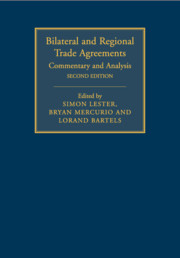Book contents
- Frontmatter
- Contents
- List of contributors
- Foreword
- Table of Cases
- Table of treaties and international agreements
- List of abbreviations
- Part I Introduction
- 1 Introduction
- Part II Economics and politics of PTAs
- Part III Relationship with WTO and international law
- Part IV Legal aspects of PTAs: A comparative analysis
- Index
1 - Introduction
from Part I - Introduction
Published online by Cambridge University Press: 05 October 2015
- Frontmatter
- Contents
- List of contributors
- Foreword
- Table of Cases
- Table of treaties and international agreements
- List of abbreviations
- Part I Introduction
- 1 Introduction
- Part II Economics and politics of PTAs
- Part III Relationship with WTO and international law
- Part IV Legal aspects of PTAs: A comparative analysis
- Index
Summary
The modern history of the world trading system, and in particular international trade agreements, is evidenced by shifts among bilateralism, regionalism and multilateralism. In the late nineteenth century and early twentieth century, bilateralism was clearly dominant. Trade agreements were negotiated on a bilateral basis between individual countries. In the 1860s and 1870s, England initiated much of this activity, pushing its trading partners to sign trade agreements that reciprocally lowered tariff rates. In the 1930s, it was the United States (US) that made a big push in this area through its Reciprocal Trade Agreements programme, although a number of other countries were also active in negotiating bilateral agreements to lower tariff rates.
However, immediately after World War II, multilateralism and regionalism replaced bilateralism as the dominant approach. From the late 1940s to the mid-1990s, multilateralism grew in strength as more and more nations joined the GATT or its successor, the WTO. The GATT, which began with 23 countries, unquestionably came to dominate the world trading scene. It did not, however, completely replace regional and bilateral trade agreements. Regionalism remained a competing model, as nations in Europe, North America, South America and elsewhere all formed trading blocs during this period. East Asia was the only region to eschew regionalism, while Western Europe was the clear leader in terms of both the timing and the scope of its economic integration, with other regions following behind. Bilateralism, on the other hand, diminished considerably during this period. Such agreements were extremely rare, and where they did exist could usually be explained mostly by political, rather than economic, factors.
More recently, though, bilateralism has returned with a vengeance. The initial return to bilateralism can be traced to the breakup of the Soviet Union and collapse of Communism in the early 1990s. The newly formed nations, along with several Eastern European economies in transition from a centrally planned to a market-based economy, led a mini-revival of bilateralism in the mid to late 1990s. Bilateralism, however, only significantly gained momentum following the failed WTO negotiations at the 1999 Seattle Ministerial Conference.
- Type
- Chapter
- Information
- Bilateral and Regional Trade AgreementsCommentary and Analysis, pp. 3 - 8Publisher: Cambridge University PressPrint publication year: 2016
- 1
- Cited by

